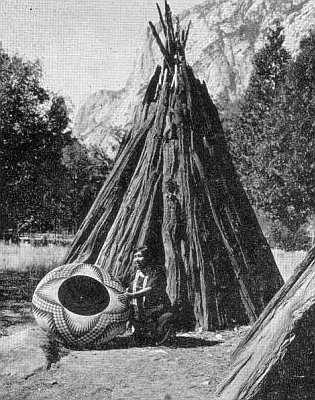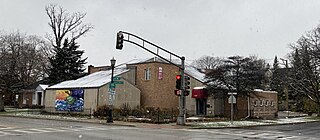
A basket is a container that is traditionally constructed from stiff fibers, and can be made from a range of materials, including wood splints, runners, and cane. While most baskets are made from plant materials, other materials such as horsehair, baleen, or metal wire can be used. Baskets are generally woven by hand. Some baskets are fitted with a lid, while others are left open on top.

Basket weaving is the process of weaving or sewing pliable materials into three-dimensional artifacts, such as baskets, mats, mesh bags or even furniture. Craftspeople and artists specialized in making baskets may be known as basket makers and basket weavers. Basket weaving is also a rural craft.

The Mitchell Museum of the American Indian is a museum in Evanston, Illinois that focuses exclusively on the history, culture and arts of North American native peoples. It is a Core Member of the Chicago Cultural Alliance, a consortium of 25 ethnic museums and cultural centres in Chicago.

Charles Edenshaw was a Haida artist from Haida Gwaii, British Columbia. He is known for his woodcarving, argillite carving, jewellery, and painting. His style was known for its originality and innovative narrative forms, created while adhering to the principles of formline art characteristic of Haida art. In 1902, the ethnographer and collector Charles F. Newcombe called Edenshaw “the best carver in wood and stone now living.”

Northwest Coast art is the term commonly applied to a style of art created primarily by artists from Tlingit, Haida, Heiltsuk, Nuxalk, Tsimshian, Kwakwaka'wakw, Nuu-chah-nulth and other First Nations and Native American tribes of the Northwest Coast of North America, from pre-European-contact times up to the present.

Alaska Native cultures are rich and diverse, and their art forms are representations of their history, skills, tradition, adaptation, and nearly twenty thousand years of continuous life in some of the most remote places on earth. These art forms are largely unseen and unknown outside the state of Alaska, due to distance from the art markets of the world.

Delores E. Churchill is a Native American artist of Haida descent. She is a weaver of baskets, hats, robes, and other regalia, as well as leading revitalization efforts for Haida, her native language.

The visual arts of the Indigenous peoples of the Americas encompasses the visual artistic practices of the Indigenous peoples of the Americas from ancient times to the present. These include works from South America and North America, which includes Central America and Greenland. The Siberian Yupiit, who have great cultural overlap with Native Alaskan Yupiit, are also included.

Chilkat weaving is a traditional form of weaving practiced by Tlingit, Haida, Tsimshian, and other Northwest Coast peoples of Alaska and British Columbia. Chilkat robes are worn by high-ranking tribal members on civic or ceremonial occasions, including dances. The blankets are almost always black, white, yellow and blue.

Kelly Jean Church is a black ash basket maker, Woodlands style painter, birchbark biter, and educator.
Annie Antone is a Native American Tohono O'odham basket weaver from Gila Bend, Arizona.

Jennie Thlunaut was a Tlingit artist, who is credited with keeping the art of Chilkat weaving alive and was one of the most celebrated Northwest Coastal master weavers of the 20th century.
Primrose Adams was a Canadian First Nations artist and member of the Raven Clan from the Haida nation. She wove hats and baskets in the Haida method and is most notable for her spruce root basketry, which involves working in the traditional manner of collecting and dyeing her own spruce root. Adams died in January 2020.

Teri Rofkar, or Chas' Koowu Tla'a (1956–2016), was a Tlingit weaver and educator from Sitka, Alaska. She specialized in Ravenstail designs and spruce root baskets.

Mary Kawennatakie Adams was a Canadian Mohawk First Nations textile artist and basket maker.
Pat Courtney Gold was a Wasco Native fiber artist and basket weaver from the Columbia River area of Oregon. She graduated with a BA in mathematics and physics from Whitman College and worked as a mathematician-computer specialist before beginning her career in basket weaving. Gold harvested traditional plant fibers to use in her work, including dogbane, cattail, sedge grass, red cedar bark and tree roots. Her pieces often reflected the natural world along the Columbia River, mixing traditional motifs such as condors and sturgeon with contemporary elements like airplanes. Gold also became an environmental and cultural educator, helping to spread knowledge of her ancestral heritage and basketry skills.
Lily Hope is an Alaska Native artist, designer, teacher, weaver, Financial Freedom planner, and community facilitator. She is primarily known for her skills at weaving customary Northwest Coast ceremonial regalia such as Chilkat robes and ensembles. She owns a public-facing studio in Juneau, called Wooshkindein Da.àat: Lily Hope Weaver Studio which opened downtown in 2022. Lily Hope is a mother of five children, and works six days a week.

Cherish Nebeshanze Parrish is a black ash basket maker and birchbark biter. She is a member of the Match-e-be-nash-she-wish Band of Pottawatomi Indians of Michigan and of Odawa descent.
Evelyn Vanderhoop is a Haida Nation artist from Masset, British Columbia, Canada. She paints and is a textile artist, specializing in Chilkat weaving and Raven's Tail weaving.

Vicki Lee Soboleff is a Haida and Tlingit artist, dancer, and teacher who specializes in Haida basketry. She was awarded the Margaret Nick Cooke Award in 2016 from the Alaska State Council on the Arts and the Alaska Humanities Forum for her work with Alaska Native dance.















